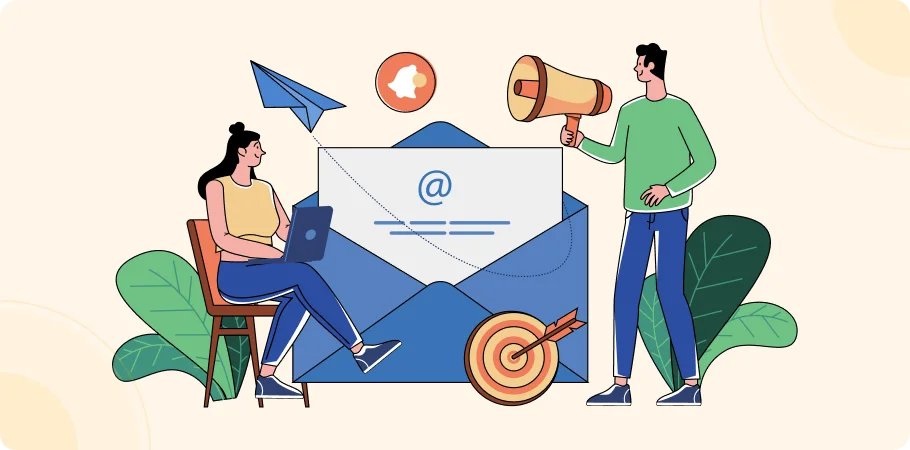You might be thinking that getting the email address of potential partners is enough for Business, and you have done everything. But WAIT! Do the emails you will be sending, will they even look at them? Writing a compelling business introduction letter sets the path right, hence you have to work on that part.
It helps you establish meaningful connections with them. When entering a new market, a well-crafted business introduction letter can be a vital tool for building connections with potential clients and partners.
A well-crafted email showcases your professionalism, clarity, and intent. It sets the tone for future conversations.
You have to show potential ones your values and how you can help them, and your brand is better than that of your competitors. Summing it up in a single email won’t be an easy task, but you have to be creative from your side and be on point.
A thoughtfully written introduction letter for Business can open doors to potential partnerships that drive growth and innovation.
By clearly articulating your goals following a proper business introduction letter format and aligning them with the recipient’s interests, you create a foundation for mutual success.
Note: Emails are 40x more effective at acquiring new customers than social media platforms.
Why Business Introduction Emails Matter?

It’s a strategy that can transform potential connections into lasting partnerships. These emails serve multiple purposes, including building relationships, exploring new opportunities, and establishing credibility in the industry.
You remember the person mostly by their first impression. The same goes for emails. Your subject lines and content decide whether the prospect will take it seriously or dismiss it.
Just like another brand’s email, you don’t want yours to sit idly in the inbox. That is a wasted resource and time. Ask your team to be patient while drafting the first email, get proper data, understand the pain points, and then write the content for the same.
Step by Step Guide to Write Introduction Business Email
Subject Line
The majority of people open emails that have attractive subject lines. It is the key factor in determining whether your email gets opened or not. It should be brief, ideally under 50 characters, and convey the purpose of the email. Just like the subject line, the first paragraph should clearly present the main points and purpose right from the start.
For example, ‘Exploring Partnership Opportunities with [Recipient’s Company Name]’ is direct and informative.
If you are known to the prospect, then you can be quirky with the subject lines. This would spark up the conversation in a better way.
Opening Greeting
The basic thing is including the name of the recipient to personalize the email and make it feel less generic. Use a formal greeting like ‘Dear (Name)’ Unless you have a prior relationship that allows for a more casual tone.
Introduction
Keep your and your company’s introduction short, and highlight your role and what your Business does. Briefly mention how your expertise can help address the lead’s issue to establish relevance and credibility.
This will work,
‘I’m [Your Name], [Your Position] at [Your Company], a leading provider of [Your Service/Product].’
Value Proposition
Without talking or appraising anything that the prospect has been doing. Clearly move to value and how your company will provide solutions that would be mutually beneficial.
Align the common goals and challenges. Ensure that you provide relevant information that demonstrates your understanding of the recipient’s needs and how your solutions can address them. This could be access to new markets, expertise, or resources.
Call-to-Action
Emails with a clear call-to-action (CTA) receive 47% higher response rates.
A clear CTA defines the next step. This could be scheduling a call, meeting, or requesting a follow-up conversation.
For example,’ I’d love to discuss this further over a quick call next week. Would you be available?’
Closing
End the email on a polite and professional note. Express gratitude for the recipient’s time and include your contact information for easy follow-up.
A well-crafted email signature with your contact details and company branding can enhance the overall impression of your email.
A simple closing like “Thank you for considering my proposal. I look forward to hearing from you soon. Best regards, [Your Name]” is effective.
Business Introduction letter examples
1: Introducing Your Business to a Potential Client
Subject Line: Exploring Opportunities for [Client’s Company Name]
Dear [Client’s Name],
I hope this message finds you well! As a prospective client, I believe our services could greatly benefit your operations. I’m [Your Name], [Your Position] at [Your Company], a leading provider of [Your Service/Product].
We specialize in [specific area of expertise]. I came across [Client’s Company] and was impressed by your work in [specific achievement].
I believe our services could enhance your operations by [specific benefit].
I’d love to discuss this further over a quick call next week. Would you be available?
Thank you for considering my proposal. I look forward to hearing from you soon.
Best regards,
[Your Name]
[Your Contact Information]
2: Introducing Your Business to a Potential Partner
Subject Line: Exploring Mutual Growth Opportunities with [Partner’s Company Name]
Dear [Partner’s Name],
Hope you are doing great!
I’m [Your Name], and I work as [Your Position] at [Your Company]. We create innovative solutions in [specific area of expertise]. Our brand identity is built on innovation and excellence, which aligns perfectly with your company’s values.
We are really impressed by [Partner’s Company] ‘s commitment to [specific initiative or value].
As our teams have analyzed, our companies share a common goal of [shared objective]. For the benefit of both of our customers, we can build a strong service.
It would be amazing if we could work together for more development and innovation.
Let’s schedule a call to discuss potential collaboration opportunities. Would you be available for a 30-minute call on [Proposed Date]?
Thank you for considering this opportunity. I look forward to hearing from you soon.
Best regards,
[Your Name]
[Your Contact Information]
3: Introducing Your Business to a Conference Attendee
Subject Line: Building on Our Connection from [Conference Name]
Dear [Attendee’s Name],
I hope you enjoyed [Conference Name] as much as I did! I’m [Your Name], [Your Position] at [Your Company]. We had a great talk about [specific topic] at the event.
I wanted to check in about our talk. Here are some extra insights on how our services can help you reach [specific goal]. For instance, we helped an example client company achieve significant improvements in [specific area].
Our team created a special method for [specific challenge]. It has shown great results for businesses like yours.
I believe our collaboration could lead to significant improvements in [specific area]. Let’s schedule a call to explore how we can tailor our solutions to meet your needs.
Would you be available for a quick call next week?
Thank you for your time, and I look forward to reconnecting.
Best regards,
[Your Name]
[Your Contact Information]
The 3rd Business introduction letter sample can be modified for other purposes, too. The email content is concise and on point, and the main purpose is mentioned. The rest can be discussed over a call.
When you address the problems these partners are facing, they give you their time and interest. These Business-to-business introduction letter templates serve as a direct communication way to pave your way smoothly.
Boost Your Business
Performance with CRMOne
Our experts will guide you through the most effective
ways to use CRMOne,
ensuring you fully leverage its
features for maximum impact on your business.
Common Mistakes to Avoid

Writing Long Emails
Some brands write emails like an essay. Don’t be like them. Too lengthy business introduction letters can overwhelm the readers and cause them to lose their attention.
Keep it concise and focused on the key points that you want to convey. Include enough relevant detail to demonstrate your understanding and expertise, but avoid overwhelming the reader with excessive information. Aim for a length that lets you cover the introduction and value proposition and propose a next step.
Using Generic or Impersonal Language
Personalized emails improve click-through rates by 14%.
Generic emails often feel like spam and fail to engage the reader’s attention. Reference specific details about their company or interest.
Tailoring your outreach efforts with unique insights can effectively engage potential clients and showcase your expertise. This will act as proof that you have researched and understand their needs.
Here, you can use CrmOne, which has powerful AI and automation to create customer profiles so you can personalize the email content, and this will help you in many ways.
Failing to Include a Clear CTA or Next Step
Navigate them to the next step. Don’t ever think that they know. Always include a specific proposal for the next step, such as scheduling or meeting. This helps get the ball rolling and ensures that the conversation moves forward. This will help move the conversation forward.
Poor subject lines:
From my personal experience, I still open emails with attractive subject lines. A weak one can prevent email from being opened.
A strong opening in your subject line can significantly increase the chances of your email being opened and read. It should be relevant to the content but not ordinary.
Lack of Professionalism:
Note: 80% of professionals say poorly written emails negatively impact their perception of the sender’s competence.
Use proper grammar, spelling, and formatting to maintain a professional tone. Use tools that can help you set everything right in the content.
How CrmOne can help you with this?
Businesses know CrmOne for its adaptability. The strengths lie in AI, automation, sales pipeline management, and customer profile creation tools that can assist in every step.
You can easily personalize the letter by analyzing customer behavior and preferences. It helps you craft the perfect email you have always wanted.
Starting with the sales management feature that lets you highlight achievements or goals. Then comes data management that sums up partner insights so you can include these points in the content.
Customer profiles will help you tailor messages to meet specific needs or interests. Always double check the mailing addresses and contact details to ensure that your emails reach the intended recipients.
Now, let’s put it all together! With CrmOne, you can create a compelling business introduction letter that reflects professionalism, personalization, and strategic planning. Here’s a quick checklist:
- Personalize: Use AI to address individual needs.
- Alignment: Automate workflows and use pre-designed templates.
- Incorporate Insights: Add data analytics and pipeline insights to showcase strengths.
- Consistency: Ensure consistent messaging across all channels.
Design your emails as per your way. Customize accordingly with this splendid email templates by CrmOne.
Conclusion:
The manner in which you write emails has a lot of impact on your Business. From first impressions to maintaining a relationship with the partners, you have to be careful with the tone you choose and the kind of content you present to them. Crafting personalized business introduction emails can make a positive impression on potential clients and partners, increasing the likelihood of engagement.
It’s very important to personalize the business introduction letter so that when they receive it, they quickly open it rather than swiping it up. One more thing that you have to consider is keeping it mobile-friendly. The relevancy of the Business should be depicted in every paragraph of the email.
Get started for Free
Start for free today. Boost your sales by clicking the Get Started button. With CRMOne, you can manage leads, sales, and customer service all in one place.

